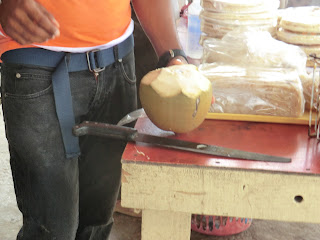The snorkeling was amazing! We hired a boat to take us out to a coral reef to view the fish that live in this area of the Caribbean. We went to the diving shop and were fitted for our gear and from there we boarded the boat; the boat was similar to the one in the national park, although a little more run down.
As I swam I saw lots of the same type of fish swimming near the surface where Beatriz (who was back in the boat) was throwing bread into the water. As I got closer to the coral I could see a greater and greater variety of fish. The smaller ones tended to stay closer to the coral while the bigger ones would swim towards the surface.

Later our boat driver took us to "natural pool" to swim. The water was beautiful and the sand was white and soft. There were several tourists boats with lots of people in the water with loud music and lots of drinking. It was also the most people from the United States that we have seen the whole time we have been here. It was almost jarring to hear so much English and to see so many people from our home country. We saw again how much tourism can bring money and jobs to the DR, but also can have such an impact on the environment. We asked our boat drive about working for the company he works for and how the pay was. Like we have heard from most Dominicans who work in the tourism industry, the pay is just ok, but the work is enjoyable. By the way, much of this economy is based on tipping and unofficial tour guides that you pay whatever you, the customer, feel is fair.


















